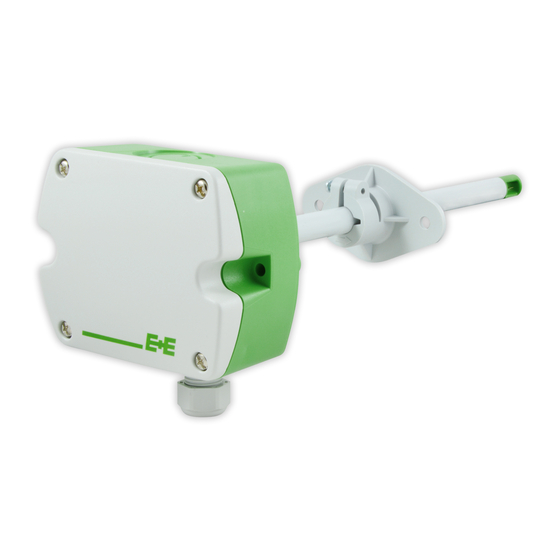Advertisement
USERʼS GUIDE
EE660 - Low Air Velocity Sensor
SCOPE OF SUPPLY
•
EE660 Low Air Velocity Sensor
•
Cable gland (two pieces at output RS485 for daisy chain wiring)
•
Mounting flange
•
Mounting materials
•
Protection cap
•
Quick guide
•
Two self-adhesive labels for configuration changes (see user guide at www.epluse.com/relabeling)
•
Test report according to DIN EN10204 - 2.2
CAUTION
•
Accurate measurement results are conditioned by the correct positioning of the sensing probe in the air stream. Best accuracy
is achieved in laminar flow.
•
Observe the minimum inlet and outlet
•
Avoid mechanical stress onto the probe and mainly onto the sensing head.
•
Observe the humidity working range 5...95% RH, non-condensing.
•
Avoid installation in corrosive environment, as this may lead to sensor destruction.
CONNECTING DIAGRAM
Analogue output
Power supply
24 V AC/DC ±20%
1 ... V+ = supply voltage
2 ... GND = ground
+
~
3 ... AV_U = voltage output air velocity
4 ... AV_I = current output air velocity
-
~
RS485 Interface
+
power supply
~
24 V AC/DC ±20 %
-
~
path length, see page 5.
V+
GND
AV_U
AV_I
mA
V
1
V+
GND
2
3
AV
V / mA
1
V+
2
GND
A (=D+)
3
RS485
B (=D-)
4
Remote probe
Address switch Remote probe
b ... brown
g ... green
y.... yellow
w... white
s.... black
b ... brown
g ... green
y ... yellow
w ... white
s ... black
S1: Response time t
ON: slow
S1 S2
OFF: fast
ON
S2: Termination resistor
120 Ohm
ON/OFF
1
2
3
4
Supply and
RS485 interface
90
1
Advertisement
Table of Contents

Subscribe to Our Youtube Channel
Summary of Contents for E+E Elektronik EE660
- Page 1 USERʼS GUIDE EE660 - Low Air Velocity Sensor SCOPE OF SUPPLY • EE660 Low Air Velocity Sensor • Cable gland (two pieces at output RS485 for daisy chain wiring) • Mounting flange • Mounting materials • Protection cap • Quick guide •...
-
Page 2: Analogue Settings
ANALOGUE SETTINGS For performing EE660 settings via EE-PCS Product Configuration Software (download from www.epluse.com/configurator) the working range jumper must be on HI. Selection of response time t Selection of measuring range Selection of response time t Jumper t90 No jumper SLOW 4 sec. - Page 3 Byte 2 Example: Response [Hex] Value in decimal 41 D5 38 5F 26.652524 Protocol setting: Address, baudrate, parity and stop bits can be set via: Product Configurator Software (available on www.epluse.com/EE660) Modbus protocol (please see Application Note Modbus (available on www.epluse.com/EE660)
-
Page 4: Configuration And Adjustment
CONFIGURATION AND ADJUSTMENT The EE660 as ordered is ready for use immediately and requires no configuration by the user. If required, the optional USB configuration adapter and the E+E Product Configuration Software (EE-PCS) can be used for changing the factory setup as well as for adjusting of the air velocity measurement. -
Page 5: Dimensions Mm (Inch)
EE660 probe, make sure that the arrow matches exactly the flow direction. INCORRECT CORRECT Air flow The mounting flange allows for precise setting of the EE660 immersion depth in a duct. The entire sensing head must be in the air flow to be measured. CORRECT INCORRECT... - Page 6 POSITIONING OF AIR VELOCITY SENSOR IN A VENTILATION DUCT The reliable and accurate measurement of air velocity depends on the correct positioning of the sensor in the ventilation duct. Accurate measurements are only possible if the air velocity probe is positioned at a location with a laminar (not-turbulent) flow. The required length of the calming section after a fault is a function of the tube diameter D.
- Page 7 E+E Elektronik Ges.m.b.H. doesn‘t accept warranty and liability claims neither upon this publication nor in case of improper treatment of the described products. The document may contain technical inaccuracies and typographical errors. The content will be revised on aregular basis. These changes will be implemented in later versions.

















Need help?
Do you have a question about the EE660 and is the answer not in the manual?
Questions and answers